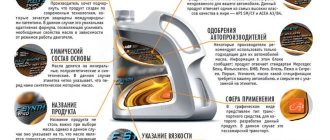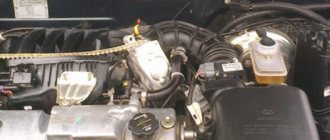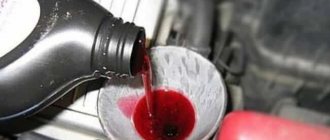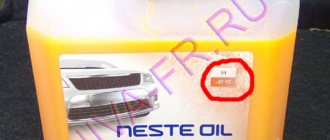The concept of operating oil temperature
During engine operation, increased pressure and a significant increase in heat occur, which negatively affect the surface of parts. And only thanks to the optimal temperature indicator of the lubricant, these negative factors are localized. According to reference literature, the operating temperature of the oil in the car engine should be +92 - +105 degrees Celsius.
Even a slight deviation from this parameter can cause serious damage to the unit. The boiling point of a lubricant depends on the use of certain brands of additives. So, some additives provide boiling at a level of +180 degrees, while others can increase this indicator to +195 degrees.
Lubricant viscosity
The lubricating fluid is designed to perform its main function - to protect the power unit from dry friction, since under such conditions parts and mechanisms quickly wear out, which in turn leads to either local breakdown or complete failure of the engine. Therefore, the lubricant must have good viscosity and be pumped through the oil channels.
When developing engines for cars, specialists take into account all the characteristics of base oils - operating temperatures at which the lubricating fluid does not lose its qualities, as well as anti-corrosion, anti-acid, anti-wear properties and many other important indicators. Usually some specific fuel is used, for which the power unit is “created”
All possibilities for changing engine oil parameters under various influences are also taken into account. One of these parameters is viscosity.
Mercedes oil viscosity test
The viscosity indicator indicates what temperature loads the lubricant can withstand. Also important is the volatility of the product, which is related to the flash point. It is determined by heating the liquid in a special device - a crucible. The lubricant does not just flare up, but burns - this can be determined by passing a lit match or wick over the liquid. In this case, the range of temperature changes is permissible up to 2 degrees per minute.
The optimal temperature at which the fuel does not start to boil may be 225 degrees Celsius.
Why is boiling grease dangerous?
The boiling point of 5w40 motor oil is +200 degrees and the boiling process of the lubricant itself is accompanied by the formation of many bubbles in the liquid and the formation of a significant amount of deposits that can tightly clog the gaps between parts. In addition to gaps, such deposits can clog the channels through which lubricant circulates. The boiling process can quickly turn into ignition of fuel and lubricants. In order for the oil to ignite, a temperature of + 230 - + 240 degrees is required. The boiling level also depends on the brand of oil.
But many experts argue that ignition can occur already at + 150 degrees. Indeed, during the combustion of oil, vapors are released, which cause premature ignition of the liquid.
In addition, the following negative processes can occur in the power unit:
- destruction of the protective oil layer located on the surface of parts;
- an increase in the friction force and destruction of the surface of parts or its complete failure;
- reducing the gap between rubbing parts with their subsequent jamming;
- a layer of soot forms on the surface of the parts and solids accumulate;
- failure of pistons and cylinders;
- engine tripping occurs and glow ignition occurs;
- detonation of an explosion inside the power unit.
Good to know: Rating of motor oils 2021 synthetic 5w40?
Flash point
Motor oil, regardless of its base (mineral or synthetic), is a flammable material. When heated to a critical value, the lubricant ignites. Each brand has a flash point.
When testing liquids, two special techniques are used:
- In a closed crucible, conditions are created that are similar to real work inside the engine crankcase. As a rule, the combustion temperature with this method is 120°C - 150°C.
- In an open crucible, a situation similar to lubricant getting on the hot parts of the exhaust tract is simulated. Under such conditions, the flash point is 180°C - 230°C.
The second test is not absolutely correct. In real conditions, the ignition temperature of oil is lower and is 150°C - 190°C. This is due to the fact that free oil in the engine compartment forms additional vapors mechanically.
However, this indicator speaks more about fire safety (more precisely, insecurity). This value has nothing to do with the technical characteristics of lubricants. If engine oil leaks, the muffler pipe (temperature from 250°C to 750°C) can become a source of fire.
Important! The flash point directly depends on the amount of vapor released under certain conditions. In fact, this is a direct dependence on the boiling point. In turn, the degree of evaporation of motor oil depends on the presence of volatile fractions
This indicator is influenced by both the chemical composition of the base and the amount of additives based on flammable components
In turn, the degree of evaporation of motor oil depends on the presence of volatile fractions. This indicator is influenced by both the chemical composition of the base and the amount of additives based on flammable components.
Main symptoms of boiling
Changing thermostat data. Each car in its configuration has a special indicator on the dashboard that shows the temperature and condition of the lubricant. When the unit is normally warmed up, the indicator sensor should be in the middle position. And as soon as the car owner notices even a slight deviation towards the red line, this is a serious sign of an increase in oil temperature.
- Characteristic sound. When the lubricant boils, the motorist can hear a characteristic boiling sound, which an experienced motorist will not confuse with anything.
- The appearance of smoke . If smoke appears from the engine compartment, this may be a sign of boiling lubricant.
- Presence of black exhausts. At the initial stage of boiling of the lubricant, you can see characteristic blue-black exhaust from the exhaust pipe.
The influence of low temperatures on engine starting stability
When purchasing a lubricant, you need to familiarize yourself with the winter parameters of the fluid, since they determine the quality of starting the internal combustion engine in the cold season. If you are using a 5W-40 class lubricant, then subtract 35 from the number 5 (this is a constant number for all types of oils). We get -30 - this is the minimum temperature at which the lubricant can start the engine without problems.
Low temperature parameters
It is necessary to take into account not only the ambient temperature, but also the power unit, since the operation of the engine is determined by the vehicle’s mileage and loads.
There are low-temperature properties of the working fluid, which include:
- Pumpability. This parameter means a state in which the substance is pumped without problems through the channels of the lubrication system.
- Product rotation. This value indicates the dynamic characteristics of the viscosity of lubricants, as well as the temperature at which the lubricant becomes most liquid. In this state, starting the engine will be easier. The cranking temperature is always 5 degrees higher than the pumping temperature.
User Vlas Prudov made a video in which he talked about choosing a high-quality fluid for a machine engine.
Freezing
The value of the pour point is determined by the loss of mobility and fluidity properties of the liquid. When the viscosity parameters increase sharply, this leads to the beginning of the wax crystallization process. Oil operating at low temperatures will be less mobile. The lubricant hardens, which leads to an increase in ductility as a result of the release of hydrocarbon substances. The pour point of the motor fluid corresponds to the minimum circulation parameter. If the oil begins to solidify, starting the engine is possible, but it will be very difficult.
Solidification temperature
The solidification temperature is 3-5 degrees lower than solidification. When it gets very cold, the fluid base becomes harder, making it impossible for it to pass through the channels of the lubrication system. Accordingly, the driver will not be able to start the power unit. This problem is more pressing for residents of northern regions, who fill their cars with oils that do not meet the viscosity class for use in such conditions.
Loading …
What to do if the grease boils?
The boiling point of 5w30 motor oil is +207 degrees Celsius. And if symptoms of lubricant boiling are noticed, then you need to immediately turn off the engine. The main thing is not to panic. But if this problem was discovered during heavy traffic, and you can’t stop right away, then you need to perform the following steps:
- reduce the load on the car engine by reducing the number of revolutions to a minimum;
- turn on the auto furnace to the maximum possible operating mode, thereby removing some of the superheated air from the working area and thereby reducing the concentration inside the engine;
- It is possible to drive at idle speed on the highway until the car comes to a complete stop.
- As soon as you manage to completely stop the car, you must immediately turn off the engine.
What characterizes the process of “boiling” oil?
When we say that the oil has “boiled,” we mean that the substance has begun to bubble. The lubricant is volatile, which means it evaporates quickly, forming a large amount of deposits. Sediment and scale clog cracks and gaps between parts and remain in the channels where the lubricant moves. As a result, the engine is left without reliable protection and can quickly become unusable.
Despite the fact that many manufacturers indicate the ignition temperature of oil at 230-240 degrees Celsius, the actual figures are much lower than 150-190 degrees. This is due to the fact that oil vapors also form in the system and provoke early ignition of the lubricants. It turns out that the actual flash point largely depends on the amount of steam formed during boiling.
Main causes of the problem
- The motorist's use of low-quality lubricant. After all, it is a low-quality lubricant that will not be able to cope with strong temperature changes, since under such conditions the lubricant loses its viscosity and begins to burn and evaporate.
- Not replacing the lubricant in a timely manner. Outdated oil is not able to perform its functions properly.
- There are malfunctions in the cooling system. If this system has problems with fan operation, a faulty fluid coupling, or contamination of the radiator, then these faults can cause boiling.
Flashes and solidification of engine oil
Flashes
The condition at which a flash appears on the surface of the lubricant when a gas flame is applied to it is called flash point. When the lubricant is heated, oil vapors are concentrated, which promote ignition.
There are differences in flash and ignition temperature states that are related to the method of testing and the apparatus itself. The temperature state of flash and ignition are indicators of the volatility of the working substance, which determine its type, as well as the degree of its purification.
But the temperature states of ignition and flash cannot characterize the operation of the lubricant in the engine and its quality.
Freezing
If a substance ceases to be viscous and mobile, then this is called the pour point. A sharp increase in viscosity and the process of crystallization of paraffin is what characterizes hardening. A lubricant that is exposed to low temperatures becomes immobile and viscous. It gains a harder consistency and plasticity due to the release of hydrocarbon components.
The pour point is equivalent to the maximum minimum temp. fluid circulation and engine lubrication system.
Motor oils from LiquiMoly
Recommendations for selection and replacement
- A lubricant with a high high-temperature viscosity is used for sports cars.
- But you should not use a product with this rating in a regular car. When choosing a lubricant, you need to rely on the vehicle operating instructions.
- Do not use a product with a high level of properties that are higher than those specified by the vehicle manufacturer.
- There is no need to pay special attention to the color of the lubricant, since the additives it contains make it dark.
- Replace the lubricant within the time frame specified by the manufacturer of your car.
- If the car often moves off-road, then such conditions require changing the lubricant 1.5-2 times more often than required by the instructions.
- It is worth replacing oxol more often if the car has significant mileage.
- If the color of oxol has changed, this does not mean that its performance properties have been lost. The lubricant washes away deposits in the engine.
- It is better not to mix mineral and synthetic petroleum products.
- Top up with the same grade that is already in the engine.
- You don't have to flush the engine if the fluid was replaced on time.
Auto mechanics performing replacements
Summarizing
The boiling point of motor oil has a significant effect on the operation of a car engine. As can be seen from the material presented above, an excessive increase in the temperature of the lubricant is a rather dangerous ailment that every motorist can encounter. You can reduce the likelihood of this problem occurring by performing timely vehicle diagnostics and using only high-quality lubricants.
Good to know: Boiling point of antifreeze
Every motorist should know that each brand of oil has its own boiling level. So the boiling point of 5w40 motor oil is +200, and the boiling point of 5w30 motor oil can reach + 207 degrees Celsius.
Olive oil
A unique product for dressing salads, making sandwiches and light snacks. The boiling point of olive vegetable oil allows it to be used for frying. The result is luxurious baked goods with unique taste. Refined oil has a high boiling point - 242 degrees. It can be easily identified by the Light marking. This is the best option for making pizza, frying meat and vegetables.
If you want to preserve all the properties of this product, then you should buy oil marked Virgin. It contains vitamins E, K, A and E, as well as fatty acids. This is an excellent remedy for preventing cardiovascular diseases, improving digestion and detoxifying the body. It boils at a temperature of 160 degrees. But in order to preserve all the components, it is best to use it for preparing snacks.
Technical characteristics of 5W-40 - decoding
The viscosity index has a direct effect on the temperature under which the lubricant can fully operate. For use in temperate climates, oils are often selected that can work in both summer and winter, and for cold regions they are suitable with a reduced viscosity.
To determine the temperature regime of the technical fluid, subtract the number 30-35 from the first digit of the SAE index, the resulting value will be the lower temperature limit. To derive the maximum limit for the positive temperature of the lubricant, you need to subtract 5 from the second number of the index.
5W-40 is a multi-grade oil that must maintain fluidity at negative and positive temperatures within specified limits in order to qualify for this SAE class. As I have said in other articles, SAE can be an indicator of the climate in which the oil can be used, only partially and only in relation to the low temperature indicator. In general, this is an indication of the viscosity of the oil at different temperatures.
We recommend: Oil Visco 3000 10v40 reviews
SAE 5W-40 viscosity values table:
| Characteristic | Index | Decoding |
| Pumpability | -35℃ | Minimum temperature at which oil is pumped through the channels |
| Turnability | -30℃ | The minimum temperature at which the engine can be started. |
| Kinematic viscosity at 100 degrees | 12.6-16.3 mm2/s | The indicator must be within these limits for the oil to be labeled 5W-40. |
| Kinematic viscosity at 40 degrees | 89-97 mm2/s | The same thing, but at a different temperature. This indicator is less important than viscosity at operating temperature. |
| Dynamic viscosity CCS at -30 degrees | No more than 6600 mPas | That is, the closer the indicator is to this limit, the worse the crankshaft will turn already at -30 degrees. |
| Flash point | From 224℃ | Can vary +/- 10-15 degrees. |
| Freezing point | About -45℃ | May vary. This indicator indicates the temperature at which the oil will completely freeze and will not be able to be pumped through the channels. |
From this table it is clearly seen that the second two symbols in marking 40 show what viscosity the oil will have exactly at operating temperature, that is, it indicates the thickness of the oil film and how easily and quickly the oil will pass through the system. It is very important to select this indicator according to the manufacturer’s recommendations, since different engines have different design features.
The first number 5 is an indication of low-temperature viscosity, that is, at -30℃ the oil will retain sufficient fluidity to crank the crankshaft.
According to GOST, the oil will be marked 3з/14. According to the API, it most often has a class SN, according to ACEA A1/B1 2010.
Tips for choosing a lubricant
What oil fluid should I buy to ensure reliable protection of the parts of my own car? Your best bet, of course, is to choose a product that your auto manufacturer recommends. Determining the optimal characteristics of a petroleum product for an engine is a complex process. The manufacturer conducts many different tests to determine which oil will be most suitable for any engine.
In real conditions, the range of permissible temperature conditions may expand. This is due to the climate, which in the Russian Federation is quite harsh (especially in winter). Every car owner should be able to select the optimal lubricant, based on the recommendations of the manufacturer of their car, as well as on real road conditions. This provides an opportunity to maximize the operational life of any vehicle, be it a car, a minibus or a truck.











